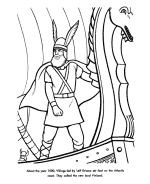




|
 |
 |
| |
Events in US History Coloring Sheets
Colonization of North America coloring pages
|
| |
|

|

The Discovery of North America
(1000-1750)
Leif Ericson - The Vilings discovered North America
Christopher Columbus - Columbus Discovers North America
Ponce de Leon - Ponce deLeon "Fountain of Youth" in Florida
Vasco Núńez de Balboa - Balboa Discovery of Pacific Ocean
Ferdinand de Soto - DeSoto discovers the Mississippi River
|
| |
The Norse colonization of the Americas began as early as the 10th century, when Norse sailors (often referred to as Vikings) explored and
settled areas of the North Atlantic, including the northeastern fringes of North America.
While the Norse colony in Greenland lasted for almost 500 years, the continental North American settlements were small and did not develop
into permanent colonies. While voyages, for example to fetch timber, are likely to have occurred for some time, there is no evidence of
enduring Norse settlements on mainland North America
For some centuries after Christopher Columbus' voyages opened the Americas to large-scale colonization by Europeans, it was unclear whether these stories represented real voyages by the Norse to North America. The sagas were first taken seriously when in 1837 the Danish antiquarian Carl Christian Rafn pointed out the possibility for a Norse settlement in or voyages to North America.
The Skálholt-mapNorth America, by the name Winland, was first mentioned in written sources in a work by Adam of Bremen from approximately 1075.
It was not until the 13th and 14th centuries that the most important works about North America and the early Norse activities there, namely
the Sagas of Icelanders, were put into writing.
The question was definitively settled in the 1960s when a Norse settlement was excavated at L'Anse aux Meadows in Newfoundland by the
archaeologist Anne Stine Ingstad and her husband, outdoorsman and author Helge Ingstad.
Columbus in modern history is often called the European discoverer of America and the person who brought the Americas into the forefront of
Europe's attention. Columbus rediscovered the Americas, after the indigenous people had over 10,000 years earlier. After his activities the
major sea powers in Europe sent expeditions to the New World: to export its riches; build trade networks and colonies; and through the Indian
Reductions practice to relocate, use the labor of, and attempt Christian conversions of the native people in their own homeland.
With the Age of Discovery starting in the 15th Century, Europeans explored the world by ocean searching particular trade goods, slaves, and
trading locations and ports. The most desired trading goods were gold, silver and spices. Columbus did not reach Asia, but rather found what
was to the Europeans a New World, the Americas.
Columbus and other Iberian explorers were initially disappointed with their discoveries - unlike Africa or Asia, the Caribbean islanders had
little to trade with the Castilian ships. The islands thus became the focus of colonization efforts. It was not until the continent itself was
explored that Spain found the wealth it had sought in the form of abundant gold. In the Americas the Spanish found a number of empires that were
as large and populous as those in Europe. However, small bodies of Spanish conquistadors, with large armies of indigenous Americans groups,
managed to conquer these states. The most notable amongst the conquered states were the Aztec empire in Mexico (conquered in 1521) and the
Inca empire in modern Peru (conquered in 1532). During this time, pandemics of European disease such as smallpox devastated the indigenous
populations. Once Spanish sovereignty was established, the Spanish focused on the extraction and export of gold and silver.
*** Historical information courtesy of Wikipedia ***
|
|
|
|
 |
|


|

